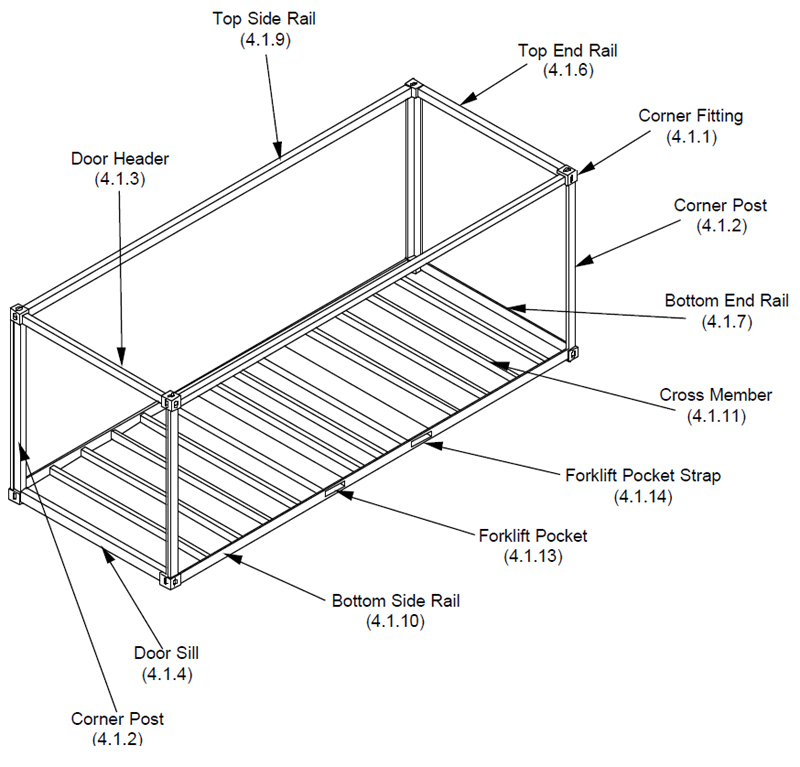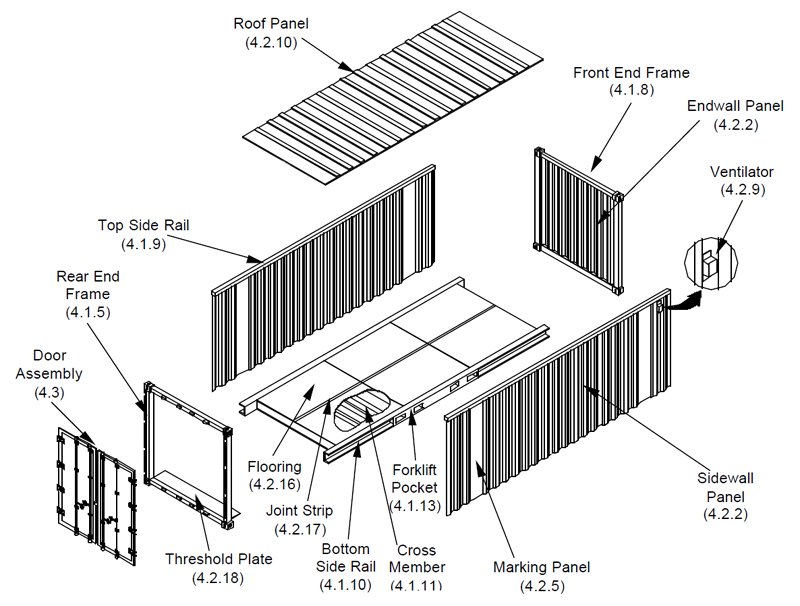Container structure
Note: On some ISO shelters, some of the primary structural components may be concealed within the wall, roof, and floor panels. The areas where the adjacent panels join will be thoroughly inspected. This inspection will meet the criteria for the Wall Beams and the Roof Beams
4.1.1 Corner Fitting. Internationally standard fitting (casting) located at the eight corners of the container structure to provide means of handling, stacking and securing containers. Specifications are defined in ISO 1161.
4.1.2 Corner Post. Vertical structural member located at the four corners of the container and to which the corner fittings are joined.
4.1.3 Door Header. Lateral structural member situated over the door opening and joined to the corner fittings in the door end frame.
4.1.4 Door Sill. Lateral structural member at the bottom of the door opening and joined to the corner fittings in the door end frame.
4.1.5 Rear End Frame. The structural assembly at the rear (door end) of the container consisting of the door sill and header joined at the rear corner fittings to the rear corner posts to form the door opening.
4.1.6 Top End Rail. Lateral structural member situated at the top edge of the front end (opposite the door end) of the container and joined to the corner fittings.
4.1.7 Bottom End Rail. Lateral structural member situated at the bottom edge of the front end (opposite the door end) of the container and joined to the corner fittings.
4.1.8 Front End Frame. The structural assembly at the front end (opposite the door end) of the container consisting of top and bottom end rails joined at the front corner fittings to the front corner posts.
4.1.9 Top Side Rail. Longitudinal structural member situated at the top edge of each side of the container and joined to the corner fittings of the end frames.
4.1.10 Bottom Side Rail. Longitudinal structural member situated at the bottom edge of each side of the container and joined to the corner fittings to form a part of the understructure.
4.1.11 Cross Member. Lateral structural member attached to the bottom side rails that supports the
flooring.
4.1.12 Understructure. An assembly consisting of bottom side and end rails, door sill (when applicable), cross members and forklift pockets.
4.1.13 Forklift Pocket. Reinforced tunnel (installed in pairs) situated transversely across the understructure and providing openings in the bottom side rails at ISO prescribed positions to enable either empty capacity or empty and loaded capacity container handling by forklift equipment.
4.1.14 Forklift Pocket Strap. The plate welded to the bottom of each forklift pocket opening or part of bottom siderail. The forklift pocket strap is a component of the forklift pocket.
4.1.15 Gooseneck Tunnel. Recessed area in the forward portion of the understructure to accommodate transport by a gooseneck chassis. This feature is more common in forty foot and longer containers.
4.2 Walls, Roof, and Floor. Refer to Figure 4.2A
4.2.1 Fiberglass Reinforced Plywood (FRP). A material constructed of laminates of fiberglass, polyester resins, and plywood, also known as sandwich panel.
4.2.2 Wall Panel. Corrugated or flat sheet steel, a riveted or bonded aluminum sheet and wall post assembly, FRP, foam and beam, aluminum, or honeycomb material that forms the side wall or end wall.
4.2.3 Wall Post. Interior or exterior intermediate vertical component to which sheet aluminum or steel is riveted or welded to form a wall panel.
4.2.4 Wall Beam. Encapsulated vertical component to which sheet aluminum or steel is bonded to form a wall panel.This is found in foam and beam panels.
4.2.5 Marking Panel. A side wall panel of a corrugated steel configured with a flat portion used for the display of markings and placards. (4.2A)
4.2.6 Lining. Plywood or other like material attached to the interior side and end wall to protect the walls and/or cargo and facilitate loading operations.
4.2.7 Lining Shield. A strip of thin metal installed at the bottom of the interior walls to protect the lower portion of the lining from damage by materials handling equipment during loading or unloading operations.
4.2.8 Kick Plate. A common name for a lining shield installed on the lower portion of the interior front end wall.
4.2.9 Ventilator. Two or more devices permanently attached to the side or end wall panel that provides openings for the exchange of air (but not water) between the outside and the container interior. (4.2A)
4.2.10 Roof Panel. Corrugated or flat sheet steel, sheet aluminum, FRP, or foam and beam and aluminum honeycomb panel that forms the top closure of the container. (4.2A,)
4.2.11 Roof Bow. Lateral non-structural member attached to the top side rails and supporting the underside of the roof panel. Roof bows used with removable cover (tarp) assembly are unattached. Not all container designs require roof bows.
4.2.12 Roof Beam. Encapsulated horizontal component to which sheet aluminum or steel is bonded to form a roof panel.
4.2.13 Roof Reinforcement Plate. An additional metal plate on the interior or exterior of the roof panel adjacent to the top corner fittings that provides protection of the roof panel or top rail components from misaligned handling equipment.
4.2.14 Tarp. Jargon for “tarpaulin” which is a waterproof and flexible fabric used for covering the top of an open-top container. This covering is referred to as a “Tilt” in some countries.
4.2.15 TIR Cable. Plastic sheathed wire rope that is designed in accordance with TIR customs convention (Refer to paragraph 4.5.6) and is threaded through the welded loops on the sides, end panels and door panels of an open-top container to secure the tarp.
4.2.16 Flooring. Material that is supported by the cross members and bottom rails to form a load bearing surface for the cargo. The flooring is usually constructed of laminated wood planks, plywood sheets, or other composition material and is screwed or bolted to the cross members. Some containers have welded steel or aluminum flooring, sandwhich panels or a combination of metal and wood. (4.2A)
4.2.17 Joint Strip. A formed steel or aluminum strip (usually hat-shaped section) installed between joints of the plywood sheet flooring or joints of the plywood sheet lining to help integrate and support the edges of the plywood. (4.2A)
4.2.18 Threshold plate. Plate forward of the door sill to protect the entrance area of the container floor. This plate is commonly referred to as a crash plate.
4.2.19 Steps. Folding steps are found on some ISO Shelters and are used to gain access to the roof. They must be folded up prior to transporting shelter.
4.2.20 Sandwich Panel. A type of fixed or removable panel construction used in ISO Shelters consisting of a thin inner and outer sheet aluminum skin, bonded or fastened to a core constructed of either honeycomb or structural foam and aluminum beams.
4.2.21 Striker Plate. An additional metal plate on the exterior of the roof panel adjacent to the top corner fittings that provides protection to the roof panel or top rail components from misaligned handling equipment.
4.2.22 Sling Pad. An additional metal plate on the exterior of the roof panel located in the center of the roof panel that provides protection to the panel from lowered handling equipment.
Examples
Plans
http://www.cargocontainerhomes.net/container-home-plans/html
http://gracie-senseandsimplicity.blogspot.tw/2011/05/shipping-container-homes-6-inspiring.html
http://www.designboom.com/weblog/cat/9/view/19119/patrick-partouche-maison-container-lille.html
http://firmitas.org/#artistic
http://www.architecturelist.com/2009/03/17/shipping-container-multi-family-development-in-slc-ut/
http://www.thecoolist.com/cordell-house-shipping-container-architecture/
http://www.arnewde.com/architecture-design/container-homes-for-the-tropics-in-costa-rica/
http://inhabitat.com/harbinger-sg-blocks-prefab/
http://gliving.com/atlanta-shipping-container-house/
http://www.architecture-view.com/2010/05/20/city-shelter-two-million-shipping-containers-in-haiti-storms/
http://www.architecture-view.com/2010/11/03/retransform-shipping-container-opera-at-eichbaum-station-german/
http://www.treehugger.com/green-architecture/recycled-shipping-container-glamping-beach-resort-buenos-aires.html
http://theworldofjoyce.com/2010/08/07/container-homes/
http://blog.architectureaddiction.com/index.php/a/2010/06/08/p423
台灣廠商
http://www.ginifab.com/forwarder/used_cargo_containders.html
http://www.container.com.tw/contact.htm
http://www.jenwa.com.tw/questions.html






網誌管理員已經移除這則留言。
回覆刪除This is nice and great blog.G P Hardware is among the most prominent distributors and suppliers of a wide variety of Industrial Hardware Products. There range includes a vast variety of Pipes and Fittings, hand tools and rubber products.FRP Roofing sheet manufacturers
回覆刪除I have got the good information through your blog; I will share this to my friends as well.
回覆刪除Shipping Containera
What is a Shipping Container
Nice work. Protect your walls by stainless steel crash rail. Choose from our collection of beautiful aluminum crash rail with modern design.
回覆刪除Really glad to read this post. Hingham's the best storage unit provider offers portable storage unit sizes for all storage needs in Southen Massachusetts. Get A Storage Quote today.
回覆刪除Pods Cohassett
It is amazing and wonderful to visit your site.
回覆刪除conex box
Useful Information, your blog is sharing unique information.
回覆刪除Conex Box
Thanks for sharing this blog, its really informative for sure, keep it sharing.
回覆刪除portable storage units Fair Oaks
Really glad to see this post as i was looking for portable storage units from a long time, keep sharing such blogs.
回覆刪除Moving and storage Quincy
Keep sharing these informative blogs, I really appreciate the efforts made by the blogger.
回覆刪除Pods Stoughton
作者已經移除這則留言。
回覆刪除Stay updated on the innovations in Shipping Container on Twitter.
回覆刪除I would like to appreciate you for this posting. In this blog you provide us great information. Thanks for sharing it.
回覆刪除Portable Storage Units Brockton
I have checked all your blog, Really you guys rocks. Nice bunch of information and tips for users. I hope you will deliver same kind of good and quality blogs in future also. All the best for your blogging.
回覆刪除Buy Storage Containers Clare Michigan